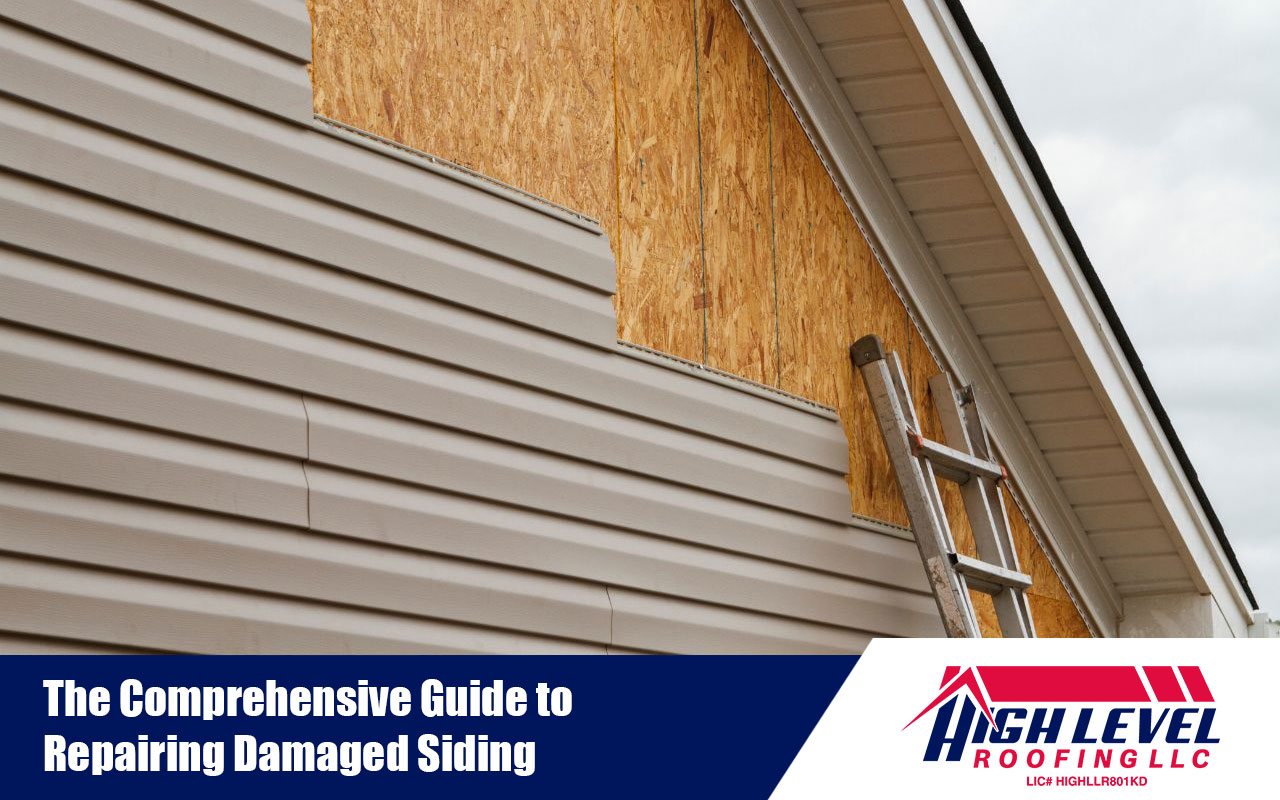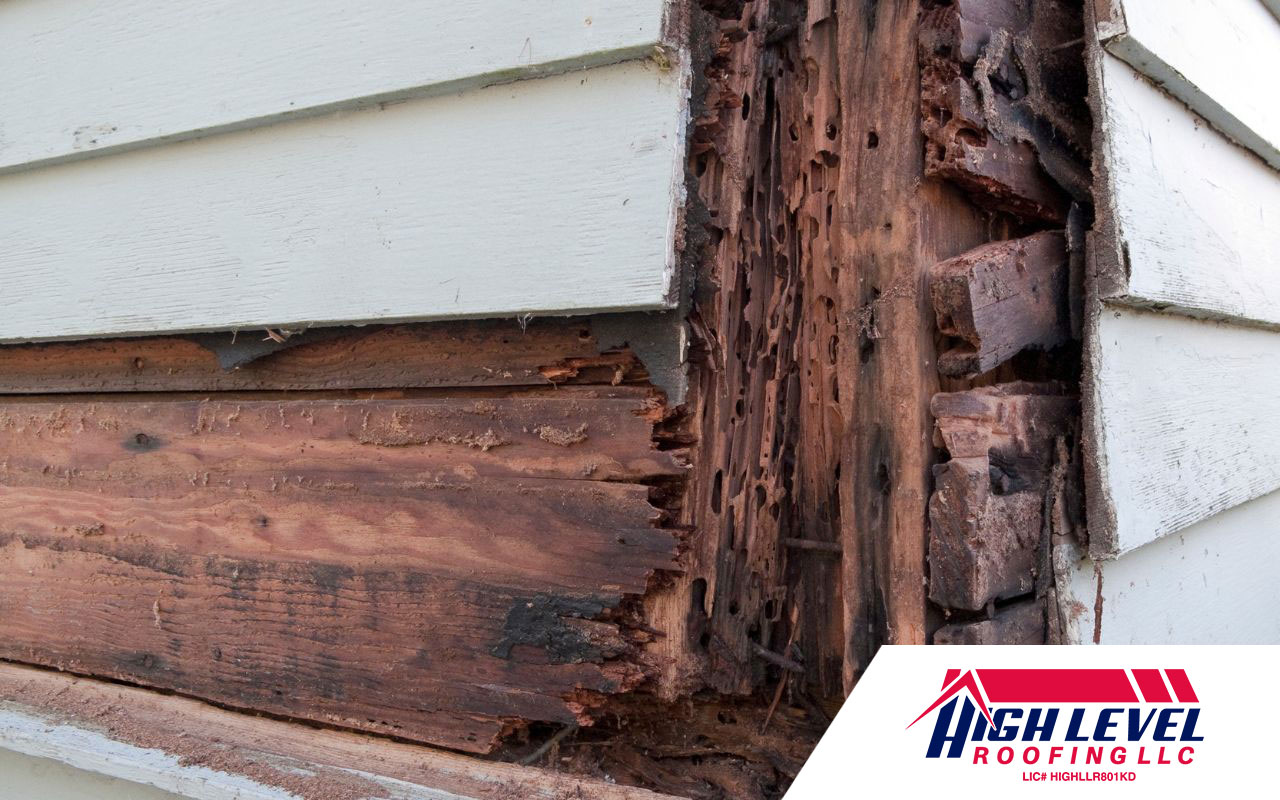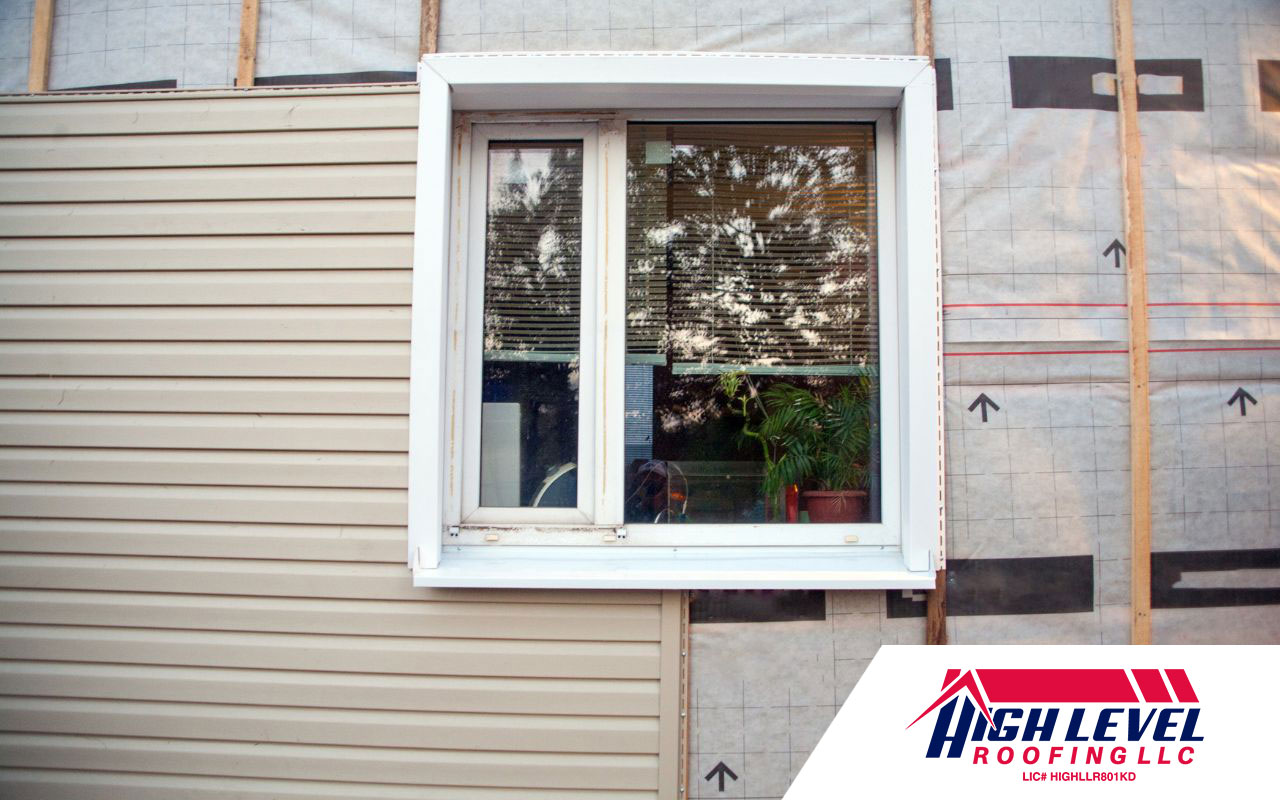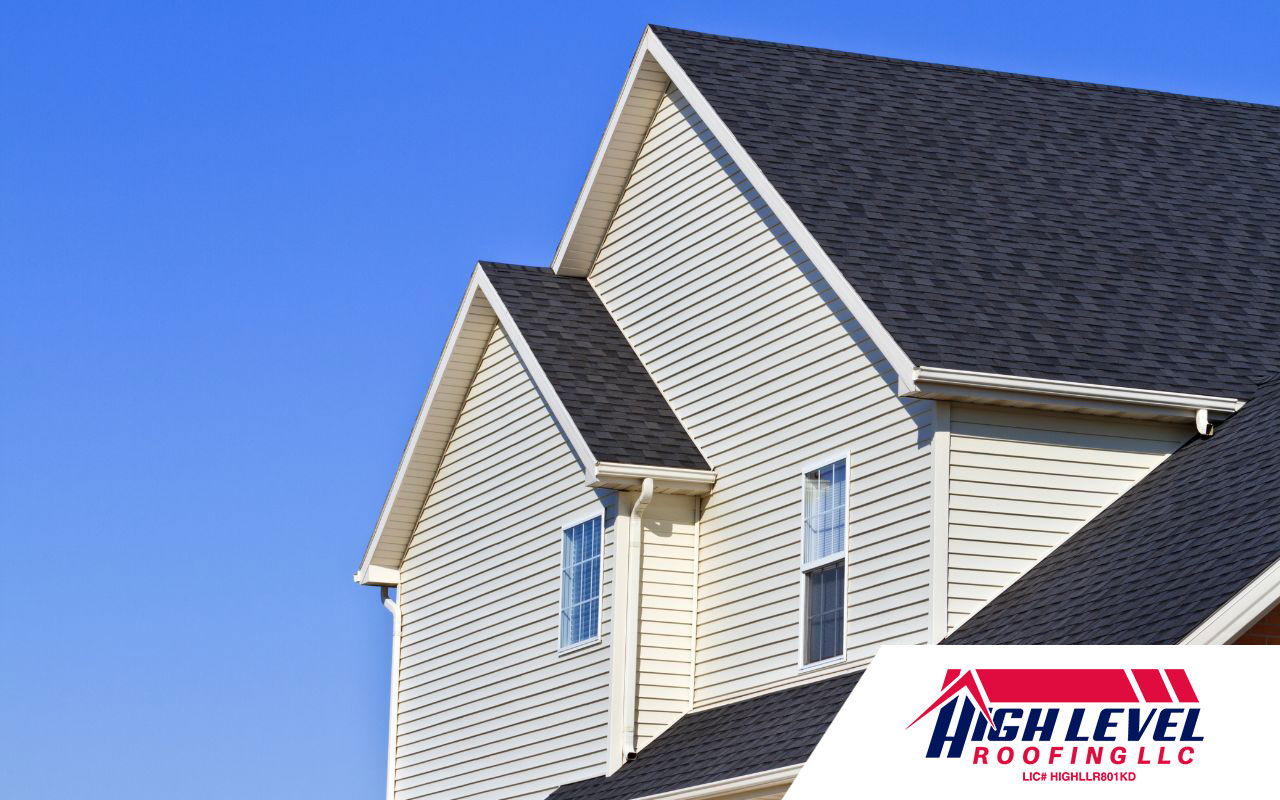
Table of Contents
Common Types of Siding Materials and Damage
How to Repair Damaged Vinyl Siding
Gather the Necessary Tools and Materials
Prepare the Replacement Panel (if applicable)
At High Level Roofing LLC, we know that maintaining the exterior of your home is crucial for its aesthetic appeal and protection against the elements. One critical aspect of this maintenance is addressing damaged siding. This comprehensive guide will help you understand the different types of siding materials, how to repair damaged vinyl siding, when to call professional siding installers, and the importance of timely siding repair.
Common Types of Siding Materials and Damage

Siding plays a crucial role in protecting and enhancing the appearance of our homes. It serves as the outer covering that shields our houses from the elements, such as rain, wind, and sunlight. However, over time, siding can become damaged due to various factors, such as weather conditions, age, or improper maintenance. In this article, we will explore the common types of siding materials and the types of damage they may encounter.
Vinyl Siding
Vinyl siding is one of the most popular choices for homeowners due to its affordability, durability, and low maintenance requirements. However, it is not impervious to damage. Common issues with vinyl siding include cracking, fading, warping, and sagging. Extreme temperatures, impacts from hail or debris, and prolonged exposure to sunlight can all contribute to these problems.
Wood Siding
Wood siding offers a natural and timeless aesthetic that many homeowners find appealing. However, it requires regular maintenance to prevent damage. Common issues with wood siding include rotting, splitting, warping, and insect infestations. Exposure to moisture, termites, or other wood-boring insects can cause significant damage to the wood, compromising its structural integrity.
Fiber Cement Siding
Fiber cement siding is a durable and low-maintenance option that resembles the look of wood or masonry. It is resistant to rot, fire, and pests. However, improper installation or damage from impacts can result in cracks, chips, or breakage. Additionally, if the siding is not properly sealed or painted, it can absorb moisture and lead to swelling or delamination.
Aluminum Siding
Aluminum siding is known for its strength, longevity, and resistance to fire. However, it is susceptible to dents, corrosion, and fading. Hailstorms, fallen branches, or accidental impacts can cause visible dents or punctures in aluminum siding. Additionally, exposure to saltwater or harsh chemicals can lead to corrosion, which compromises its structural integrity.
Stucco Siding
Stucco siding is a popular choice for its durability and ability to insulate homes. However, it is prone to cracking and water damage. Settlement of the house’s foundation, temperature fluctuations, or improper installation can result in cracks on the stucco surface. These cracks allow moisture to seep in, leading to further damage, including mold growth and structural issues.
Brick Siding
Brick siding is renowned for its strength, longevity, and aesthetic appeal. It can withstand various weather conditions and requires minimal maintenance. However, it is not entirely immune to damage. Mortar erosion, water penetration, or foundation movement can cause cracks or crumbling in the brickwork. Additionally, environmental factors like freeze-thaw cycles can lead to spalling, where the surface layer of bricks flakes off.
Composite Siding
Composite siding combines various materials, such as wood fibers and synthetic resins, to create a durable, low-maintenance siding option. It offers the appearance of natural wood with enhanced resistance to moisture, rot, and insects. However, composite siding can still experience issues like fading, cracking, or swelling if it is not properly maintained or if there are manufacturing defects.
Homeowners must understand the common types of siding materials and the types of damage they may encounter. Regular inspections and proper maintenance can help identify and address any issues early on, ensuring the longevity and appearance of your home’s siding. If significant damage occurs, it is advisable to consult with a professional siding contractor to assess the situation and determine the best course of action.
How to Repair Damaged Vinyl Siding

Vinyl siding is a popular choice for homeowners due to its affordability, durability, and low maintenance requirements. However, over time, it can become damaged due to factors such as impacts, extreme weather conditions, or improper installation. Repairing damaged vinyl siding is a relatively straightforward process that can help maintain the integrity and appearance of your home’s exterior. In this article, we will guide you through the steps of repairing damaged vinyl siding.
Assess the Damage:
Begin by examining the damaged area of the vinyl siding. Look for cracks, holes, or sections that have become loose or dislodged. Assess the extent of the damage to determine whether a repair or replacement is necessary.
Gather the Necessary Tools and Materials:
To repair damaged vinyl siding, you will need the following tools and materials:
- Utility knife
- Pry bar
- Replacement siding panel (if needed)
- Exterior-grade adhesive or caulk
- Nails or screws (if needed)
- Hammer or screwdriver
- Paint or touch-up pen (optional for color matching)
Remove the Damaged Section:
If the damaged section of vinyl siding is cracked or broken, you will need to remove it. Use a utility knife to score along the top edge of the damaged siding panel. Then, gently remove the panel from the siding channels using a pry bar or your hands. Be careful not to damage the surrounding panels during this process.
Prepare the Replacement Panel (if applicable):
If you need to replace the damaged panel, measure the length needed and cut the replacement panel accordingly. Use a utility knife or tin snip to make a straight cut. Ensure the replacement panel matches the style and color of the existing vinyl siding.
Install the Replacement Panel:
Slide the replacement panel into the bottom edge of the siding channel, fitting it securely into place. Make sure it aligns properly with the surrounding panels. If necessary, trim the panel further to achieve a perfect fit. Use exterior-grade adhesive or caulk along the edges of the panel to secure it in place.
Reattach Loose Sections:
If the damaged section of vinyl siding is still intact but has become loose or dislodged, you can reattach it. Apply exterior-grade adhesive or caulk to the backside of the loose section, then carefully reposition and press it firmly into place. Use nails or screws if needed to secure the panel, making sure they are hidden within the grooves or overlapping sections of the siding.
Inspect and Touch Up:
Once the repair is complete, inspect the repaired section for any visible gaps or imperfections. Apply additional adhesive or caulk as needed to ensure a tight seal. If necessary, use paint or a touch-up pen that matches the color of the vinyl siding to conceal any noticeable marks or blemishes.
Regular Maintenance:
To maintain the longevity and appearance of your vinyl siding, perform regular maintenance tasks such as cleaning with a mild detergent and a soft brush and inspecting for any signs of damage or wear. Promptly address any issues to prevent further damage and ensure the long-term protection of your home’s exterior.
Repairing damaged vinyl siding is a relatively simple process that homeowners can do with basic DIY skills. However, if you are unsure about the repair or need more tools, it is advisable to consult with a professional siding contractor for assistance. By addressing damaged vinyl siding promptly, you can preserve its functionality and aesthetics, enhancing your home’s overall beauty and value.
How to Repair Damaged Wood Siding
Wood siding offers a classic and timeless aesthetic to homes, but over time, it can become damaged due to various factors like moisture, insect infestation, or age. Fortunately, repairing damaged wood siding is a feasible task that can help restore its beauty and functionality. We will guide you through the process of repairing damaged wood siding.
Assess the Damage:
Begin by thoroughly inspecting the damaged area. Look for signs of rot, insect infestation, cracks, or loose boards. Determine the extent of the damage and identify any underlying issues that may have caused it.
Gather the Necessary Tools and Materials:
To repair wood siding, you will need the following tools and materials:
- Pry bar or crowbar
- Hammer
- Nails
- Exterior-grade wood filler or epoxy
- Sandpaper
- Exterior-grade primer and paint that matches the existing siding
- Paintbrushes
- Saw (if replacement boards are required)
Remove Damaged Sections:
Carefully remove any loose or damaged boards using a pry bar or crowbar. Be cautious not to damage the surrounding siding during this process. If the damage is extensive, you may need to cut out the damaged section using a saw.
Treat Rot or Insect Infestation:
If you encounter rot or insect damage, addressing it before proceeding with repairs is crucial. Remove any rotted wood or infested areas, and replace them with new, sound wood. Treat the surrounding area with a wood preservative or insecticide to prevent future issues.
Fill Cracks and Holes:
Using an exterior-grade wood filler or epoxy, fill any cracks, holes, or gaps in the wood siding. Follow the manufacturer’s instructions for proper application and drying time. Once the filler has hardened, sand the surface until it is smooth and level with the surrounding area.
Secure Loose Boards:
If any boards are loose or protruding, use a hammer and nails to secure them back in place. Make sure to use corrosion-resistant nails that are suitable for exterior use. Drive the nails through the siding and into the underlying studs or furring strips for a secure hold.
Prime and Paint:
Apply an exterior-grade primer to the repaired area, following the manufacturer’s instructions. Once the primer has dried, apply a coat of paint that matches the existing siding. Feather the paint outwards from the repaired area to blend it with the surrounding siding. Apply additional coats if necessary to achieve a seamless finish.
Regular Maintenance:
To prolong the life of your wood siding and prevent future damage, make sure to perform regular maintenance tasks. This includes inspecting the siding for signs of wear, keeping it clean from dirt and debris, and repainting or resealing as needed.
Repairing damaged wood siding is a task that requires attention to detail and patience. If you are uncertain about the extent of the damage or lack the necessary skills, it is advisable to consult a professional contractor specializing in siding repairs. With proper care and timely repairs, your wood siding can regain its charm and protect your home for years to come.
When to Call Professional Siding Installers
While homeowners can often do minor repairs, more extensive damage or complex siding materials may require the expertise of professional siding installers. High Level Roofing LLC’s experienced professionals are well-equipped to handle all types of siding repair and replacement, ensuring your home’s exterior remains in top condition.
The Benefits of Timely Repair

Addressing damaged siding as soon as possible offers several benefits:
- Cost-effective: Repairing minor issues early can prevent more extensive (and expensive) damage later on.
- Curb appeal: Maintaining your siding keeps your home looking its best and can even boost property value.
- Protection: Properly maintained siding helps protect your home from water damage, pests, and other potential issues.
Protect and Preserve Your Home with Timely Siding Repair
To sum up, understanding how to repair damaged siding is crucial for maintaining your home’s appearance and protection. This guide should equip you with the knowledge to tackle minor repairs or when to call High Level Roofing LLC. Our team is dedicated to providing top-notch siding repair services, ensuring your home’s exterior remains in excellent condition.

